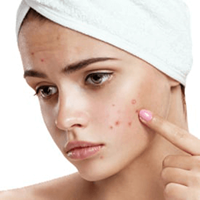About Melasma
Both hyperpigmentation and melasma cause darkened areas of skin to appear on the face, and sometimes, the forearms. The dark patches typically develop on the upper lip, on the nose, and in symmetric areas around the cheeks and eyebrows and can be grayish, brown, or tan. The unique symmetry of melasma distinguishes it from other conditions that cause the darkening of the skin. Both men and women can develop melasma, though it is much more common in females, especially in pregnancy and menopause. It can also be caused by sun damage, and existing patches of melasma can be aggravated or darkened by sun exposure. Though sun exposure does play a part in melasma, it seems to be more common in individuals with darker complexions than those with pale skin. If you have melasma and are frustrated with your appearance, consider scheduling a consultation at Pacific Skin and Cosmetic Dermatology San Francisco & Marin. Dermatologist Dr. Tracy Evans and her professional medical team can evaluate your condition and prescribe a number of treatments that can help reduce the visibility of this cosmetic condition.
About Hyperpigmentation
Also categorized as darkening areas of the skin, hyperpigmentation can have several different causes. Often linked to spending excessive time in the sun without sunscreen, hyperpigmentation may need to be treated with advanced laser treatments. Other common causes of hyperpigmentation can include acne, inflammation, and other skin injuries. At Pacific Skin and Cosmetic Dermatology San Francisco & Marin, Dr. Tracy Evans can evaluate your skin and determine the best course of treatment for your hyperpigmentation issues.
Reviews
Causes
The exact cause of melasma is unknown. Experts believe that the dark patches in melasma could be triggered by several factors, including hormone fluctuations, a family history of melasma, anti-seizure medications, and other medications that make the skin more sensitive to ultraviolet (UV) light. Darker skin seems to be more prone to developing melasma. Overexposure to sunlight is considered the leading cause of melasma, especially in individuals with a genetic predisposition to this condition. Clinical studies have shown that individuals typically develop melasma in the summer months when the sun is most intense. In the winter, the hyperpigmentation tends to be less visible or lighter. Pregnancy hormones also seem to be a trigger, as around 50% of women develop melasma while pregnant.
Symptoms
Melasma is characterized by symmetrical discoloration or hyperpigmentation primarily on the face. However, some patients do have melasma on the forearms and neck area. Three types of common facial patterns have been identified in those with melasma:
- Centrofacial (center of the face) – hyperpigmentation on the forehead, upper lip, nose, and chin
- Malar (cheekbones) – dark patterns on the upper cheeks
- Mandibular (jawbone) – discoloration along the jaw
Treatment Options
There are several options for treating melasma, but the method Dr. Evans will choose will depend on factors, like your skin type and how long you've had melasma. Dr. Evans has developed her own unique treatment plan for melasma, which she may determine is a great option for you. There are also a variety of medical-grade topical creams, gels, or lotions that can be used to exfoliate and lighten the skin. Dermatology resurfacing treatments, such as microdermabrasion, chemical peels, or fractional laser procedures, which remove old skin and promote regrowth, have also been successful. Another option is intense pulsed light therapy or IPL. Unlike lasers, which use intense, focused light, IPL is intense broadband light so the recovery time is briefer. Improvements usually last the longest when the patient implements good sun protection and skin care.
Get a Professional Diagnosis
While melasma is a very common skin condition that many women deal with, it can be tricky to treat. There are many over-the-counter remedies available, but using the wrong one can ultimately make your melasma darker. If you have experienced this problem or are simply fed up with OTC creams not working as advertised, it is time to see a professional dermatologist. Schedule your consultation with Dr. Tracy Evans or one of her experienced physician assistants at Pacific Skin and Cosmetic Dermatology San Francisco to start your journey back to an even skin tone.
Related Procedures
Related Posts
What can I do for sun damage on my chest?!
Prevention magazine sat down with Dr. Evans to talks sun damage, specifically to the chest. If you spend too much time in the sun, this is for you!
ReadAre Dark Under Eye Circles, Signs Off A Bigger Problem?
Here's how to tell the difference and what to do in case you're dealing with stubborn hyperpigmentation.
Read



